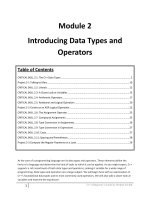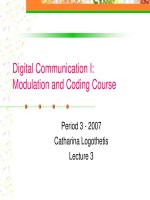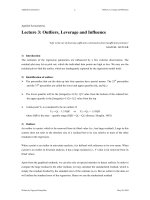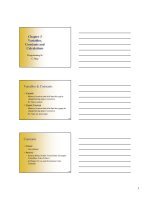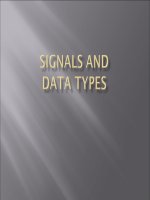Lecture 3 variables and basic data types
Bạn đang xem bản rút gọn của tài liệu. Xem và tải ngay bản đầy đủ của tài liệu tại đây (2.63 MB, 85 trang )
Ho Chi Minh City University of Technology
Faculty of Computer Science and Engineering
Chapter 3: Variables and
Basic Data Types
Introduction to Computer Programming
(C language)
TS. Võ Thị Ngọc Châu
(,
)
2017 – 2018, Semester 2
Course Content
C.1. Introduction to Computers and
Programming
C.2. C Program Structure and its
Components
C.3. Variables and Basic Data Types
C.4. Selection Statements
C.5. Repetition Statements
C.6. Functions
C.7. Arrays
C.8. Pointers
C.9. File Processing
2
References
[1] “C: How to Program”, 7th Ed. – Paul
Deitel and Harvey Deitel, Prentice Hall, 2012.
[2] “The C Programming Language”, 2nd Ed.
– Brian W. Kernighan and Dennis M. Ritchie,
Prentice Hall, 1988
and others, especially those on the Internet
3
Content
Introduction
Data
and Data Types
enum
Data Type
struct
Data Type
Variables
and Variable Declaration
Constant
Definition
Expressions
Operators
Summary
4
Introduction
Given a
set of n
positive
numbers,
Algorithm findMinNumber
-
Input: positiveNumber[n] which is an array of n positive double values
-
Output: minNumber which is the smallest one whose type is double
-
Purpose: find the smallest number in a collection
-
Precondition: n data inputs are positive.
Begin Algorithm
Check positiveNumber[n] contains only positive values
minNumber = positiveNumber[1]
find the
iteration = 2
smallest
Begin While
While (iteration <= n)
If (minNumber <= positiveNumber[iteration]) Then
one.
iteration = iteration + 1
Else
Begin
(Chapter 1 –
minNumber = positiveNumber[iteration]
iteration = iteration + 1
Pseudo code)
End
End While
5
Introduction
Given a
void main() {
set of n
double positiveNumber[10] = {2, 1, 3, 10, 8, 3, 4, 5, 9, 12};
positive
double minNumber = positiveNumber[0];
numbers,
int iteration = 1;
int n = 10;
while (iteration < n) {
find the
if (minNumber <= positiveNumber[iteration])
iteration = iteration + 1;
smallest
else {
one.
minNumber = positiveNumber[iteration];
iteration = iteration + 1;
(Chapter 1 –
}
}
Real code in C)
}
6
Introduction
Given a
void main() {
set of n
double positiveNumber[10] = {2, 1, 3, 10, 8, 3, 4, 5, 9, 12};
positive
double minNumber = positiveNumber[0];
numbers,
int iteration = 1;
int n = 10;
/* Variable declarations */
while (iteration < n) {
find the
if (minNumber <= positiveNumber[iteration])
iteration = iteration + 1;
smallest
else {
one.
minNumber = positiveNumber[iteration];
iteration = iteration + 1;
(Chapter 1 –
}
}
Real code in C)
}
7
Introduction
Given a
void main() {
set of n
double positiveNumber[10] = {2, 1, 3, 10, 8, 3, 4, 5, 9, 12};
positive
OUTPUT
double minNumber = positiveNumber[0];
numbers,
int iteration
= 1; ONES
SUPPORTING
int n = 10;
INPUT
/* Variable declarations */
while (iteration < n) {
find the
if (minNumber <= positiveNumber[iteration])
iteration = iteration + 1;
smallest
else {
one.
minNumber = positiveNumber[iteration];
iteration = iteration + 1;
(Chapter 1 –
}
}
Real code in C)
}
8
Introduction
Handle data in a C program
Input
Output
Supporting ones
What?
Declare, Store, Process (Manipulate)?
Who declares?
Who stores?
Who processes (manipulates)?
Where?
9
Introduction
Handle data in a C program
Input
Output
Supporting ones
What?
Values + Types
(Our real world)
Declare, Store, Process (Manipulate)?
Who declares? -
Who stores? -
Who processes (manipulates)? -
We
Computer
Where?
Memory
(Computer’s world)
Computer
10
Data and Data Types
Data
“information, especially facts or numbers, collected
for examination and consideration and used to
help decision-making, or information in an
electronic form that can be stored and processed
by a computer” – Cambridge Dictionary
Examples:
9.5
“Introduction to Computer Programming”
„A‟
(“59800172”, “Chau”, “IT”, 1998)
(2, 5, 10, 3, 8, 9, 4, 1, 7, 6)
1
1, 2, 3, …
…
11
Data and Data Types
Data
“information, especially facts or numbers, collected
for examination and consideration and used to
help decision-making, or information in an
electronic form that can be stored and processed
by a computer” – Cambridge Dictionary
Examples:
9.5
“Introduction to Computer Programming”
„A‟
(“59800172”, “Chau”, “IT”, 1998)
(2, 5, 10, 3, 8, 9, 4, 1, 7, 6)
1
1, 2, 3, …
…
Value
Meaning
Type
Purpose
Role
12
Data and Data Types
Data
“information, especially facts or numbers, collected
for examination and consideration and used to
help decision-making, or information in an
electronic form that can be stored and processed
by a computer” – Cambridge Dictionary
Examples:
Grade
9.5
“Introduction to Computer Programming” Name
Grade
„A‟
(“59800172”, “Chau”, “IT”, 1998) Student‟s info
(2, 5, 10, 3, 8, 9, 4, 1, 7, 6)
Stock levels
The lowest stock level
1
Iterations for problem solving
1, 2, 3, …
and so on
…
Value
Meaning
Type
Purpose
Role
13
Data and Data Types
Data
“information, especially facts or numbers, collected
for examination and consideration and used to
help decision-making, or information in an
electronic form that can be stored and processed
by a computer” – Cambridge Dictionary
(atomic,
Examples:
Types
non-atomic):
Real numbers
Grade
9.5
Sequences of characters
“Introduction to Computer Programming” Name
Characters
Grade
„A‟
Records
Sets of
elements
(“59800172”,
“Chau”, “IT”, 1998) Student‟s info
Integer numbers
(2, 5, 10, 3, 8, 9, 4, 1, 7, 6)
Stock levels
Natural numbers
The lowest stock level
1
…
Iterations for problem solving
Valuesets
manipulations
1, +
2,data
3, …
Storage
and so on
…
Value
Meaning
Type
Purpose
Role
14
Data and Data Types
Data
“information, especially facts or numbers, collected
for examination and consideration and used to help
decision-making, or information in an electronic
form that can be stored and processed by a
computer” – Cambridge Dictionary
Data Types
Represent data processed in a computer-based
program
Specify what kind of data is to be stored in memory
How much memory should be allocated
How to interpret the bits stored in the memory
Specify what operations are allowed for data
manipulation
15
Data Types in C
Built-in data types (primitive/fundamental)
char (signed char), unsigned char
short int, unsigned short, int, unsigned int, long int,
unsigned long int, long long int, unsigned long long
float, double, long double
void
enum (enumerated data associated with integers)
Derived data types
arrays [] of objects of a given type
pointers * to objects of a given type
structures struct containing objects of other types
union containing any one of several objects of
various types
16
Built-in Data Types in C
Type
Keyword
Size
Range
Characters
char
1 byte
-128 to 127
Unsigned characters
unsigned char
1 byte
0 to 255
Short integer numbers
short
2 bytes
-32768 to 32767
Unsigned short integer numbers
unsigned short
2 bytes
0 to 65535
Integer numbers
int
4 bytes
-2,147,483,648 to 2,147,483,647
(2 bytes: -32768 to 32767)
Unsigned integer numbers
unsigned int
4 bytes
0 to 4,294,967,295
Long integer numbers
long
4 bytes
-2,147,483,648 to 2,147,483,647
Unsigned long integer numbers
unsigned long
4 bytes
0 to 4,294,967,295
Single-precision floating-point
numbers (6 digits of precision)
float
4 bytes
-3.4e+38 to 3.4e+38
Double-precision floating-point
numbers (15 digits of precision)
double
8 bytes
-1.797693e+308 to
1.797693e+308
?
long long
8 bytes
?
?
unsigned long
long
8 bytes
?
?
long double
12 bytes
?
Typeless
void
1 byte
N/A
Enumerated data
enum
4 bytes
?
Size varies from system
to system!
sizeof (type_name)
should be used.
17
Built-in Data Types in C
Fig. 5.5. Promotion hierarchy for data types ([1], p. 150)
18
Built-in Data Types in C
Representation – Manipulation
char, unsigned/signed
short,
int, unsigned/signed
long
float
double
long double
…
char < short < int < long < float < double < long double
19
Built-in Data Types in C
char
Type name: char
Memory allocation: sizeof(char) = 1 byte
The smallest addressable unit in memory
Enough to store a single ASCII character
Signed range: -128..127
1 bit for sign (0 = +; 1 = -)
„A‟
+
/-
1
0
0
0
0
0
Unsigned range: 0..255
8 bits for value
ASCII = American Standard Code for Information Interchange
1
„a‟
0
1
1
0
0
0
0
1
20
Built-in Data Types in C
char
Values can be used as numbers instead of
characters.
Addition, Subtraction, Comparison
21
Built-in Data Types in C
int
Type name: int
Memory allocation: sizeof(int) = 4 bytes
Depend on the implementation: 2 bytes
Range: -231..(231-1)
= -2,147,483,648..2,147,483,648
1 bit for sign (0 = +; 1 = -)
(4x8 – 1) = 31 bits for value
Non-negative values: standard bit representation
2
0 0 0 0 0 0 0 0 0 0 0 0 0 0 0 0 0 0 0 0 0 0 0 0 0 0 0 0 0 0 1 0
Negative values: 2‟s complement = 232 – x
-2
1 1 1 1 1 1 1 1 1 1 1 1 1 1 1 1 1 1 1 1 1 1 1 1 1 1 1 1 1 1 1 22
0
Built-in Data Types in C
int
Values can be used with
the operators:
Arithmetic (+, -, *, /, …)
Relational (comparison)
…
23
Built-in Data Types in C
float
Type name: float
Memory allocation: sizeof(float) = 4 bytes
Range: -3.4e+38 to 3.4e+38
s bit (1 bit) for sign (0 = +; 1 = -)
m bits for exponent
f bits for fraction
Floating-point number =
(-1)s*f*2m
Real numbers are approximately represented.
Values can be used with the operators:
Arithmetic (+, -, *, /, …), Relational (comparison),…
Be careful with equality comparison!
24
Built-in Data Types in C
float
